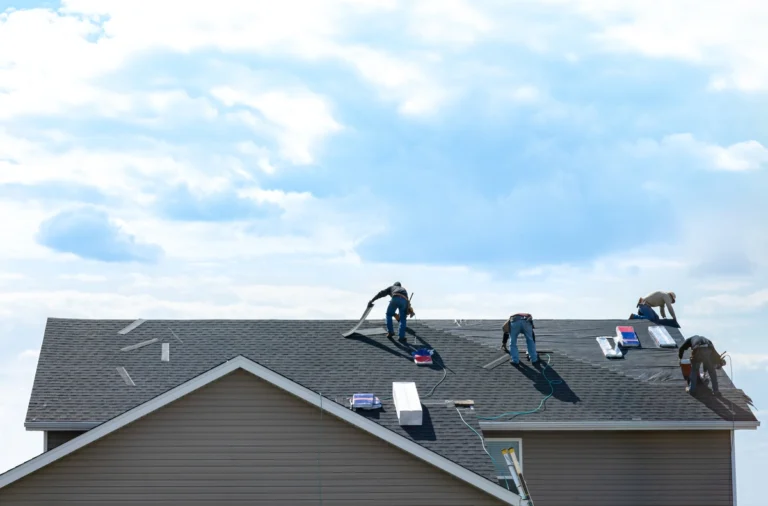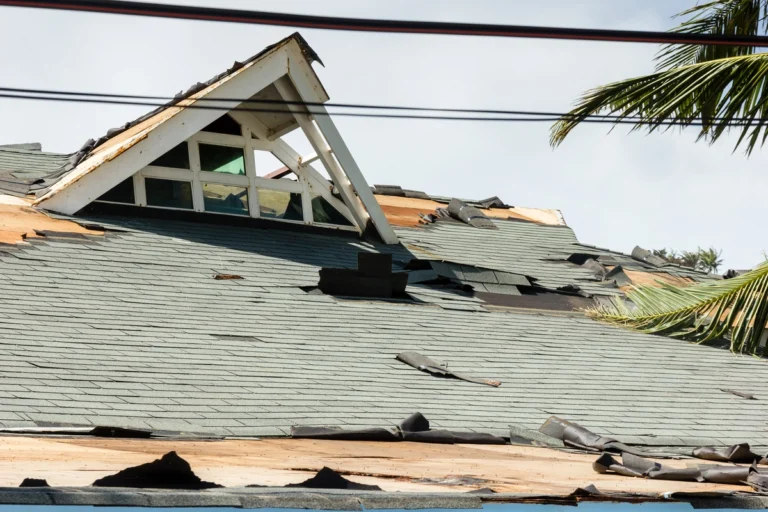Your roof is a crucial component of your home, providing protection from the elements and maintaining the structural integrity of your property. One essential aspect of roof maintenance and replacement is understanding roof pitch.
Roof pitch, often expressed as a ratio or degree, determines how steep or shallow your roof is. In this comprehensive guide, we’ll explore the significance of roof pitch, signs that indicate the need for a roof replacement, whether you should tackle the project yourself or hire a professional, a step-by-step guide on how to calculate roof pitch, and the costs associated with replacing your roof.
How to Calculate Roof Pitch Step-by-Step

Let’s delve into the heart of our guide: calculating roof pitch. Understanding your roof’s pitch is crucial when it comes to roof replacement or any roofing project. Roof pitch is typically expressed as a ratio (e.g., 4:12) or as an angle in degrees (e.g., 30°). To calculate it, follow these steps:
Step 1: Gather Materials and Tools
You’ll need the following items:
- Ladder
- Tape measure
- Level
- Pencil
- Calculator
Step 2: Choose Your Roof’s Location
Select a spot on your roof where you’ll measure the pitch. It’s best to choose a location that’s representative of the overall roof.
Step 3: Measure the Vertical Rise
Climb onto your roof safely using a ladder and place the level horizontally against the roof surface. Ensure that it’s level, and then measure the vertical distance from the roof surface to the level. This measurement is your “rise.”
Step 4: Measure the Horizontal Run
From the same point where you measured the rise, extend the level out horizontally. Measure the distance from the point where the level touches the roof to the exterior edge of the level. This measurement is your “run.”
Step 5: Calculate the Roof Pitch
Now that you have the rise and run, you can calculate the roof pitch using the following formula:
Roof Pitch (as a ratio) = Rise / Run
For example, if your rise is 6 feet and your run is 12 feet, your roof pitch is 6:12.
To express it as an angle in degrees, use this formula:
Roof Pitch (in degrees) = arctan(rise / run)
You can use a scientific calculator or an online calculator to find the arctan value and convert it to degrees.
Step 6: Interpret the Roof Pitch
Once you have your roof pitch in ratio form (e.g., 6:12) or degrees (e.g., 30°), you can interpret what it means:
- Higher numbers in the ratio (e.g., 8:12) indicate a steeper roof.
- Lower numbers in the ratio (e.g., 2:12) represent a shallower roof.
- In degrees, a higher angle (e.g., 45°) corresponds to a steeper pitch, while a lower angle (e.g., 20°) indicates a shallower pitch.
Understanding your roof’s pitch is essential for choosing the right roofing materials, ensuring proper drainage, and estimating the cost of your roofing project.
6 Signs That You Need a Roof Replacement

After understanding the intricacies of roof pitch, it’s also essential to recognize the signs that may indicate your roof is in need of replacement. Neglecting these signs can lead to more significant problems and costly repairs down the line. Here are some common indicators that your roof requires replacement:
1. Age of the Roof
The age of your roof is a crucial factor in determining whether it needs replacement. Most asphalt shingle roofs have a lifespan of 20-25 years, while other materials like metal or tile can last longer. If your roof is approaching or has exceeded its expected lifespan, it’s a good idea to consider replacement.
2. Leaks and Water Damage
Water stains on your ceiling or walls, mold growth, or visible water leaks in your attic are clear signs that your roof is failing to keep water out. Addressing these issues promptly is essential to prevent further damage to your home’s interior and structure.
3. Missing or Damaged Shingles
Inspect your roof regularly for missing, curling, or cracked shingles. Damaged or absent shingles can compromise your roof’s ability to protect your home from the elements.
4. Granule Loss

Check your gutters and downspouts for excessive granule buildup. The loss of granules from asphalt shingles indicates wear and tear, making your roof less effective at shedding water and protecting your home.
5. Sagging Roof
A visibly sagging roof is a severe issue that requires immediate attention. It suggests structural problems that may compromise the safety of your home.
6. Excessive Energy Bills
If you notice a sudden increase in your energy bills, your roof could be the culprit. A roof in poor condition may not provide adequate insulation, causing your heating and cooling systems to work harder.
DIY or Professional Roof Replacement?
Once you’ve determined that your roof needs replacement, the next decision is whether to tackle the project yourself or hire a professional roofing contractor. Here are some factors to consider when making this choice:
DIY Roof Replacement
✅ Pros:
- Cost Savings: DIY roofing can be more cost-effective, as you won’t incur labor costs.
- Sense of Accomplishment: Completing a roofing project on your own can be rewarding and provide a sense of accomplishment.
❌ Cons:
- Safety Concerns: Roofing is hazardous work, and falls from roofs can lead to severe injuries. Professionals have the necessary safety equipment and training.
- Lack of Expertise: Roofing requires expertise in various aspects, including proper installation techniques, ventilation, and waterproofing. Mistakes can lead to costly repairs.
- Time-Consuming: Roofing is a time-intensive project, and it may take longer for an inexperienced DIYer to complete the job.
Professional Roof Replacement
✅ Pros:
- Expertise: Professional roofers have the knowledge and experience to ensure your roof is installed correctly and meets industry standards.
- Safety: Roofing contractors are trained to work safely at heights, reducing the risk of accidents.
- Warranty: Many roofing contractors offer warranties on their work, providing peace of mind in case issues arise.
❌ Cons:
- Cost: Hiring professionals will incur labor costs, which can be a significant part of the overall project cost.
- Limited Control: You may have less control over the project when working with professionals, though good contractors will consult with you on important decisions.
Ultimately, the choice between DIY and professional roof replacement depends on your skill level, comfort with heights, and the complexity of the job. If you’re unsure, it’s often safer to hire a professional, especially for larger or more intricate roofing projects.
The Cost of Replacing Your Roof

Roof replacement costs can vary widely depending on several factors, including the size and pitch of your roof, the materials used, your location, and the contractor you choose. Here’s a breakdown of the typical costs associated with roof replacement:
Materials
The type of roofing material you select plays a significant role in the overall cost. Here are some common roofing materials and their approximate costs per square foot:
- Asphalt Shingles: $3 – $5 per square foot
- Metal Roofing: $7 – $12 per square foot
- Wood Shake Shingles: $6 – $10 per square foot
- Clay or Concrete Tiles: $10 – $15 per square foot
Labor
Labor costs can vary depending on your location and the complexity of the project. On average, labor can account for 60% to 70% of the total project cost. For a standard asphalt shingle roof replacement, labor costs may range from $1.50 to $3.00 per square foot.
Removal of Old Roof
If your existing roof needs to be removed before installing the new one, this will add to the overall cost. Removing an old roof typically costs between $1.00 and $2.50 per square foot.
Roof Pitch
A steeper roof pitch can increase the cost of installation due to the additional labor and safety precautions required. Steeper roofs may also require more materials.
Roof Access
The ease of access to your roof can impact costs. If your roof is difficult to reach or if obstacles need to be removed for access, this can add to the project’s expenses.
Additional Features

Adding features like skylights, chimneys, or roof vents can increase the complexity of the project and add to the cost.
Permits and Inspections
Don’t forget to factor in the cost of permits and inspections, which can vary depending on your location and the scope of the project.
Warranty and Quality
High-quality materials and professional installation may cost more initially but can save you money in the long run by reducing the likelihood of repairs and extending the lifespan of your roof.
Geographic Location
The cost of roofing materials and labor can vary significantly by region, so it’s essential to get local estimates.
To get an accurate estimate for your roof replacement project, it’s best to contact several roofing contractors in your area. They can provide you with quotes based on your specific needs and circumstances.
Let Best Exteriors Care for Your Roof
Understanding your roof’s pitch is a fundamental aspect of any roofing project, whether you’re replacing your roof or making repairs. Recognizing the signs that your roof needs replacement and making an informed decision about whether to tackle the project yourself or hire a professional are essential steps in maintaining the integrity of your home.
When you need professional help, look no further than the qualified roofing contractors at Bay Valley Roofing. We can help to create a roofing system that works for you and your specific needs. Contact us today to set up your appointment!





